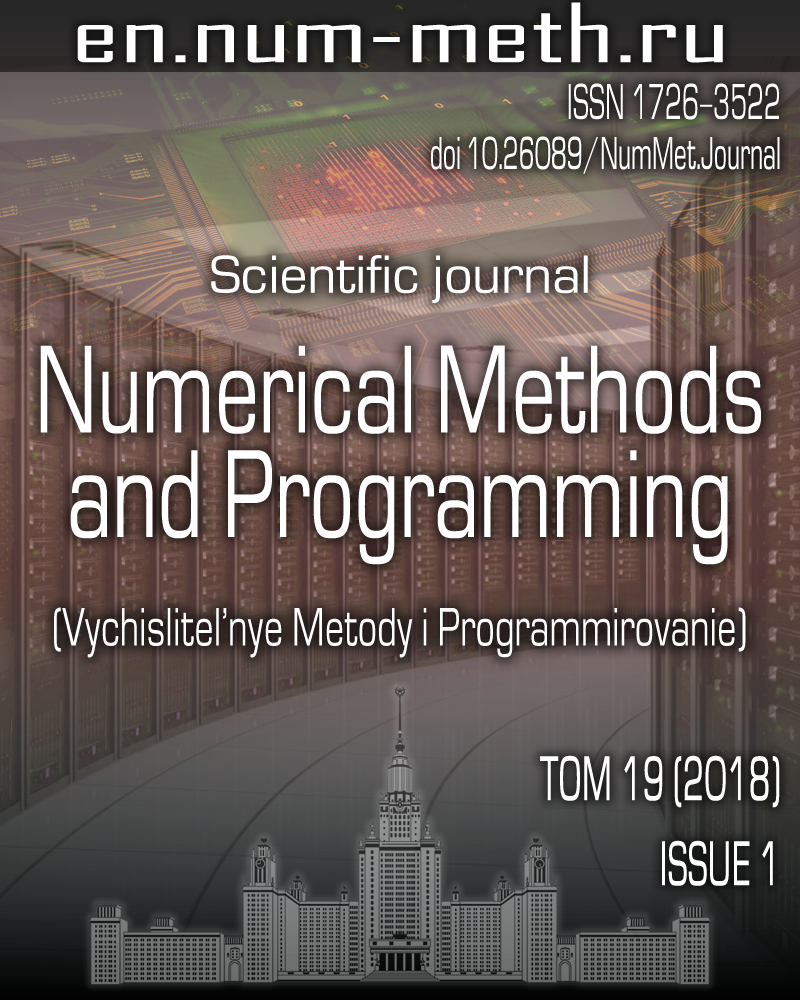DOI: https://doi.org/10.26089/NumMet.v19r102
Parallel computations on a hybrid computing system for two-phase filtration problems
Keywords:
two-phase filtration in porous media
parallel computing
graphics processors
control volume method
Abstract
The application of parallel computations to solve two-phase filtration problems with a large number of wells on a hybrid computer system is considered, which makes it possible to use the cores of the central processor and the cores of the graphics processor.
Published
2018-01-26
Issue
Section
Section 1. Numerical methods and applications
References
- S. S. Andreev, A. A. Davydov, S. A. Dbar, et al., “A Model of the MVS-Express Hybrid Supercomputer,” in Proc. 17th All-Russian Conf. on Theoretical Foundations and Development of Numerical Algorithms and Solution of Problems in Mathematical Physics with Applications to Multiprocessor Systems, Abrau-Durso, Russia, September 15-21, 2008 (Keldysh Institute of Applied Mathematics, Moscow, 2008).
- A. A. Davydov, A. O. Latsis, A. E. Lutsky, et al., “The Hybrid Supercomputer MVS-Express,” Dokl. Akad. Nauk 434 (4), 459-463 (2010) [Dokl. Math. 82 (2), 816-819 (2010)].
- B. N. Chetverushkin, D. N. Morozov, M. A. Trapeznikova, et al., “An Explicit Scheme for the Solution of the Filtration Problems,” Mat. Model. 22 (4), 99-109 (2010) [Math. Models Comput. Simul. 2 (6), 669-677 (2010)].
- D. N. Morozov, M. A. Trapeznikova, B. N. Chetverushkin, and N. G. Churbanova, “Application of Explicit Schemes to Simulation of Two-Phase Filtration Process,” Mat. Model. 23 (7), 52-60 (2011) [Math. Models Comput. Simul. 4 (1), 62-67 (2012)].
- D. N. Morozov, M. A. Trapeznikova, B. N. Chetverushkin, and N. G. Churbanova, “Simulation of Filtration Problems on Hybrid Computer Systems,” Mat. Model. 24 (10), 33-39 (2012) [Math. Models Comput. Simul. 5 (3), 208-212 (2013)].
- A. A. Lyupa, D. N. Morozov, M. A. Trapeznikova, et al., “Three-Phase Filtration Modeling by Explicit Methods on Hybrid Computer Systems,” Mat. Model. 26 (4), 33-43 (2014) [Math. Models Comput. Simul. 6 (6), 551-559 (2014)].
- B. N. Chetverushkin, “Kinetic Models for Solving Continuum Mechanics Problems on Supercomputers,” Mat. Model. 27 (5), 65-79 (2015) [Math. Models Comput. Simul. 7 (6), 531-539 (2015)].
- A. A. Lyupa, D. N. Morozov, M. A. Trapeznikova, et al., “Simulation of Oil Recovery Processes with the Employment of High-Performance Computing Systems,” Mat. Model. 27 (9), 73-80 (2015) [Math. Models Comput. Simul. 8 (2), 129-134 (2016)].
- K. Yu. Bogachev, A. S. Bogaty, and A. P. Lapin, “Use of Graphics Cards and Coprocessors for Solving Filtration Problems,” Vychisl. Metody Programm. 14, 357-361 (2013).
- A. V. Tsepaev, “Decomposition Methods for Solving Two-Phase Filtration Problems Using Graphics Processors,” in Proc. 5th Int. Conf. on Parallel Computing and Control Problems, Moscow, Russia, October 26-28, 2010 (Trapeznikov Institute of Control Sciences, Moscow, 2010), pp. 199-204.
- D. A. Gubaidullin, A. I. Nikiforov, and R. V. Sadovnikov, “Using Graphics Processors to Solve Sparse SLAE by Preconditioned Krylov Subspace Iterative Methods as Shown by the Example of Subsurface Flow Theory Problems,” Vestn. Lobachevskii Univ. Nizhni Novgorod, No. 1, 205-212 (2011).
- D. A. Gubaidullin, A. I. Nikiforov, and R. V. Sadovnikov, “GPU Sparse Library for the Numerical Solution of Continuum Mechanics Problems on a Hybrid Computing System,” Vestn. Lobachevskii Univ. Nizhni Novgorod, No. 2, 190-196 (2011).
- D. A. Gubaidullin, A. I. Nikiforov, and R. V. Sadovnikov, “A Library of Templates of Iterative Krylov Subspace Methods for the Numerical Solution of Continuum Mechanics Problems on Hybrid Computing Systems,” Vychisl. Metody Programm. 11, 351-359 (2010).
- OpenMP Architecture Review Board.
http://www.openmp.org . Cited December 29, 2017. - NVIDIA Corporation. CUDA Toolkit Documentation v9.1.85.
http://docs.nvidia.com/cuda/index.html . Cited December 29, 2017. - B. Hendrickson and R. Leland, The Chaco User’s Guide , Technical Report Sand93-2339 (Sandia National Laboratories, Albuquerque, 1993).
- D. A. Gubaidullin, A. I. Nikiforov, and R. V. Sadovnikov, “On Peculiarities of Using Heterogeneous Cluster Architecture for Solving Continuum Mechanics Problems,” Vychisl. Metody Programm. 12, 450-460 (2011).
- S. A. Dbar, L. P. Bass, A. O. Lacis, et al., “K-100 Supercomputer Maintenance Experience in the Keldysh Institute of Applied Mathematics,” Inform. Tekhnol. Vychisl. Sistemy, No. 2, 5-12 (2016).
- A. I. Nikiforov and R. V. Sadovnikov, “Solution Problems of Oil Recovery with Waterflood Using Polymer-Disperse Systems on Multiprocessor Computer Systems,” Mat. Model. 28 (8), 112-126 (2016) [Math. Models Comput. Simul. 9 (2), 221-231 (2017)].
- K. Aziz and A. Settari, Petroleum Reservoir Simulation (Appl. Sci. Publ., London, 1979; Nedra, Moscow, 1982).
- D. W. Peaceman, “Interpretation of Well-Block Pressures in Numerical Reservoir Simulation,” SPE J. 18 (3), 183-194 (1978).
- R. Courant, K. Friedrichs, and H. Lewy, “Über die Partiellen Differenzengleichungen der Mathematischen Physik,” Mathematische Annalen 100 (1), 32-74 (1928).
- A. M. Gorelik, Programming in Modern Fortran (Finansy i Statistika, Moscow, 2006).

